Rajni Trivedi*
Mangaldeep Apartment, Ahmedabad, India
*Corresponding Author: Rajni Trivedi, Mangaldeep Apartment, Ahmedabad, India.
Received: June 07, 2024; Published: September 27, 2024
Citation: Rajni Trivedi. “Important records of Solitary Snipe Gallinago solitaria from Nal Sarovar Birds Sanctuary, Central Gujarat, India”. Acta Scientific Veterinary Sciences 6.10 (2024): 32-35.
Present observation carried out to explore diversity and abudancy of Solitary snipe Gallinago solitaria in Nal Sarovar Birds Sanctuary and adjusted wetland. In this article going to introduce large sized solitary snipe G. solitaria observed and surrounding wetland during 28th Oct 2012 to 10th Jan 2024. Observation area where surveyed by spot-out feeding and roosting site of snipe. Highest abudancy and diversity were recorded during December. Most off birds were probably adult, only one or two birds were juvenile in rufous-brown, blackish-brown plumage.
Keywords: Solitary Snipe; Gallinago Solitaria; Sarovar Birds Sanctuary
The Solitary snipe G. solitaria has long slendar bill, long neck, long wing, long legs create large appearance and recognized as different and separate species than Large sized wood and Great snipe. It is split in two different race Gallinago solitaria Japonica is found South-East Siberia, North-East China through Kolymsky to Kamchapka. Another race Gallinago solitaria solitaria is found from Baluchistan, South-East Afghanistan, North-West Pakistan through Central, East, North East Himalayas – del hoyo and Rasmussen [1] gave its status of residence and breed in East Himalayas [3]. Ali has observed two birds during October and January, 1962 at Thangu, Zemu and Laching in North Sikkim without date and location. One species was collected for Sikkim survey without date and location. Two species were collected by Schafer’s when he was through Sikkim for Tibet in 1938 without date and location. Islam and Rehmani has observed single bird at Bedang Taso East Sikkim in 2018 [4-21]. has sighted two birds in June to August in breeding plumage. Ali has collected two species on 20th November, 1992 in North Sikkim at Thangu, Zemu and Laching. Chhetri and Gurung has observed and photographed two birds during April and May in East Sikkim at Bedang Taso Wetland.
Nal Sarovar Bird Sanctuary is located (22.821503505187074, 72.05712008622474) 65 km west from Ahmedabad city and 60 km East from Surendranagar city along Bagodara-Viramgam road spreaded over more than 300 sq. km. with Vekaria, Kayla, Kumarkhan, Sharad, Bhaskarpura wetland. It is fresh water body with muddy lagoon, provide excellent habitation to wintering waterfowl, raptors and passerine birds. Declare Bird sanctuary and Ramsar----- site him.
Bird is adult, has a horned black long bill, Blackish-brown crown strip, white supercilium, broad black lores, broken orbital ring, white on face, brownish-black wing coverts, pale fringed parallel scapular and mentle strips, pale fringed primary, medan and secondary coverts, rofous and black banded and white tipped tail, greenish yellow legs [3].
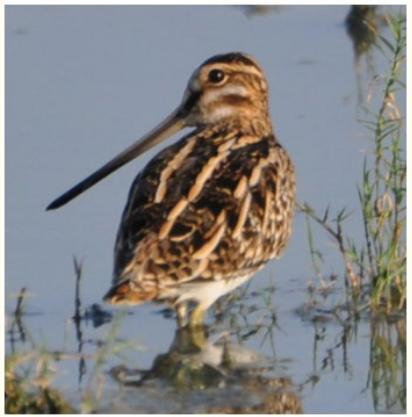
Figure 1
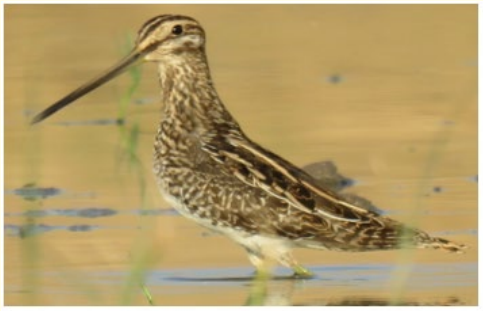
Figure 2
Bird has horned black bill, blackish-brown parallel crown strips, central strips white, pale supercilium, broad black lores, white on face, brownish-black long neck, pale fringed primary, medan and secondary coverts, pale fringed parallel scapular strips, rofous and black banded long tail. Greenish yellow legs [4].

Figure 3
Black crown strip, horned black long bill, Broad black lores, black crown ship, white supercilium, white on face, white fringed parallel scapular and mentle strips, rofous black bended white tiped tail, long greenish yellow legs [6].
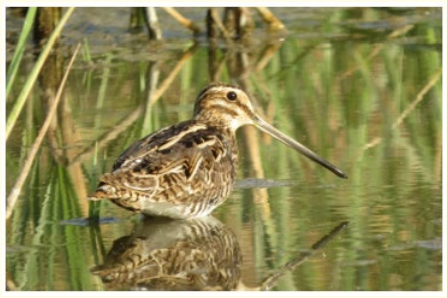
Figure 4
Brownish-black crown strip, horned Black long bill, broad black lores, white supercilium and white on face, long wing covert with white fringed parallel scapular mentle strips, black baring on flanck, rufous black banded tip long tail [7,8].
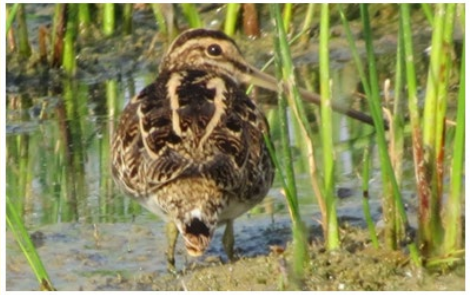
Figure 5
Black crown strip, white supercilium and orbital ring, horned black bill, broad black lores, white on face, blackish brown wing coverts with pale fringed scapular and mentale strips, rufous black bended white tipped long tail, greenish legs [9,10].
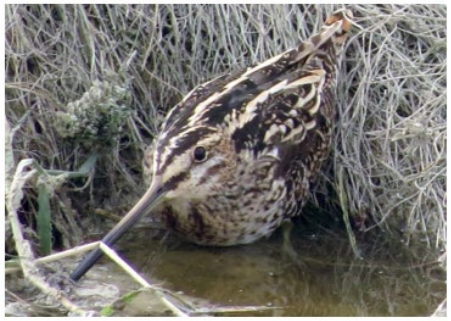
Figure 6
Black crown strip, central strip white, white supercilium, broad black lores, horned black long bill, white on face, greyish buff baring on upper breast, black wing covert with white fringed scapular and mentle strips [11].
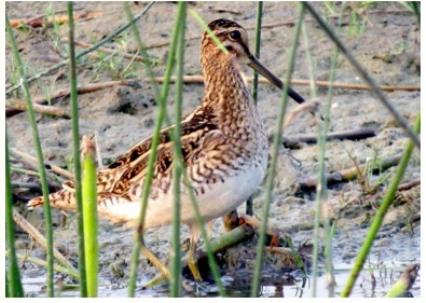
Figure 7
Probably bird is juvenile. Rofous black crown strip, white supercilium, black broad lores, white on face, horned black long bill, rufous brown baring on neck, upper breast and flank, rufous brown long wing coverts with white fringed scapular, mentle strips, black bended long tail, Greenish yellow legs [12].
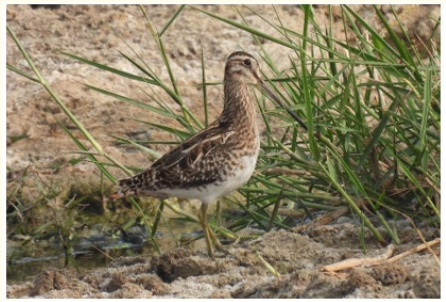
Figure 8
Bird is adult, rufous brown crown ship, white supercilium, horned black long bill, broad black lores, white on face, rufousbrown barring on neck, also on upper breast and flank, rufousbrown wing coverts with white fringed parallel scapular and mentale strips, pale fringed primary medan and secondary coverts, rufous and black banded white tiped long tail, greenish yellow legs.
Copyright: © 2024 Rajni Trivedi. This is an open-access article distributed under the terms of the Creative Commons Attribution License, which permits unrestricted use, distribution, and reproduction in any medium, provided the original author and source are credited.